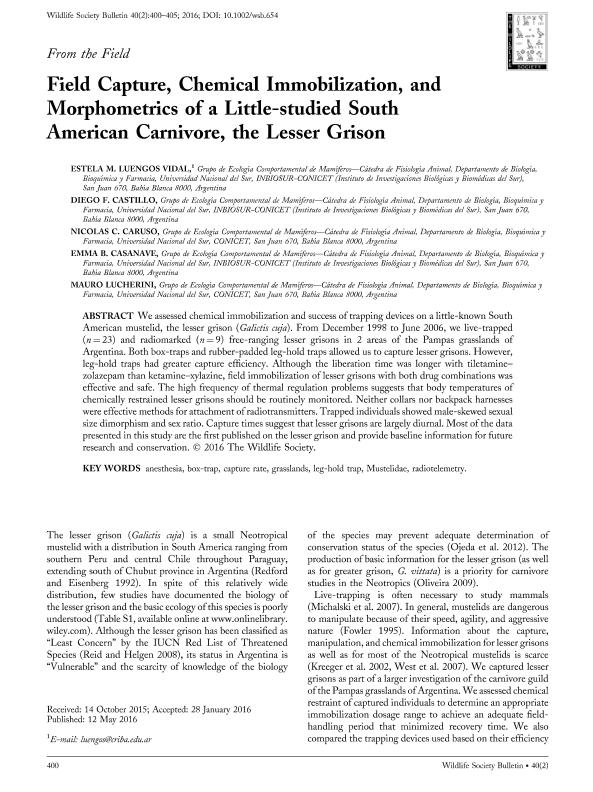Artículo
Field capture, chemical immobilization, and morphometrics of a little-studied South American carnivore, the lesser grison
Luengos Vidal, Estela Maris ; Castillo, Diego Fabián
; Castillo, Diego Fabián ; Caruso, Nicolás
; Caruso, Nicolás ; Casanave, Emma Beatriz
; Casanave, Emma Beatriz ; Lucherini, Mauro
; Lucherini, Mauro
 ; Castillo, Diego Fabián
; Castillo, Diego Fabián ; Caruso, Nicolás
; Caruso, Nicolás ; Casanave, Emma Beatriz
; Casanave, Emma Beatriz ; Lucherini, Mauro
; Lucherini, Mauro
Fecha de publicación:
05/2016
Editorial:
Wiley
Revista:
Wildlife Society Bulletin
ISSN:
0091-7648
Idioma:
Inglés
Tipo de recurso:
Artículo publicado
Clasificación temática:
Resumen
We assessed chemical immobilization and success of trapping devices on a little-known South American mustelid, the lesser grison (Galictis cuja). From December 1998 to June 2006, we live-trapped (n:23) and radiomarked (n:9) free-ranging lesser grisons in 2 areas of the Pampas grasslands of Argentina. Both box-traps and rubber-padded leg-hold traps allowed us to capture lesser grisons. However, leg-hold traps had greater capture efficiency. Although the liberation time was longer with tiletamine/zolazepam than ketamine/xylazine, field immobilization of lesser grisons with both drug combinations was effective and safe. The high frequency of thermal regulation problems suggests that body temperatures of chemically restrained lesser grisons should be routinely monitored. Neither collars nor backpack harnesses were effective methods for attachment of radiotransmitters. Trapped individuals showed male-skewed sexual size dimorphism and sex ratio. Capture times suggest that lesser grisons are largely diurnal. Most of the data presented in this study are the first published on the lesser grison and provide baseline information for future research and conservation.
Palabras clave:
Anesthesia
,
Box-Trap
,
Capture Rate
,
Grassland
,
Leg-Hold Trap
,
Mustelidae
,
Radiotelemetry
Archivos asociados
Licencia
Identificadores
Colecciones
Articulos(INBIOSUR)
Articulos de INSTITUTO DE CIENCIAS BIOLOGICAS Y BIOMEDICAS DEL SUR
Articulos de INSTITUTO DE CIENCIAS BIOLOGICAS Y BIOMEDICAS DEL SUR
Citación
Luengos Vidal, Estela Maris; Castillo, Diego Fabián; Caruso, Nicolás; Casanave, Emma Beatriz; Lucherini, Mauro; Field capture, chemical immobilization, and morphometrics of a little-studied South American carnivore, the lesser grison; Wiley; Wildlife Society Bulletin; 40; 5-2016; 400-405
Compartir
Altmétricas



